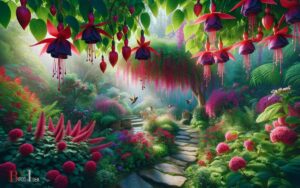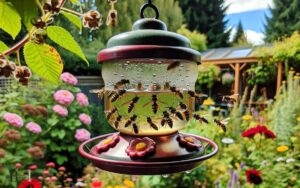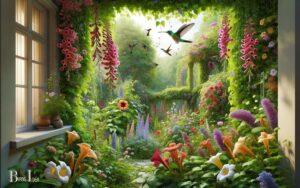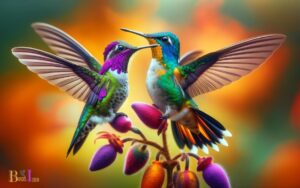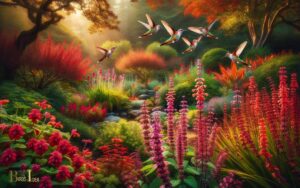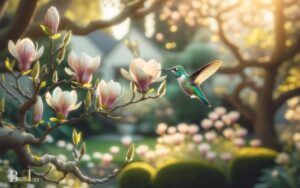How to Attract Hummingbirds on Long Island? Explore!
To attract hummingbirds on Long Island, create a habitat with native flowering plants, provide a consistent source of nectar through feeders, ensure a supply of water for bathing, and avoid the use of pesticides.
Hummingbirds are attracted to areas that fulfill their needs for food, water, and shelter.
On Long Island, creating a hospitable environment for these birds involves several key components:
By incorporating these elements, Long Islanders can successfully invite these delightful birds into their gardens.
Creating a hummingbird-friendly garden on Long Island can be a rewarding way to enjoy wildlife while contributing to the conservation of these enchanting creatures.

Key Takeaway
Understanding Hummingbird Behavior
When trying to attract hummingbirds on Long Island, it is important to understand their behavior in order to create an appealing environment for them.
Hummingbirds are attracted to brightly colored flowers with tubular shapes, as these provide them with easy access to nectar. They have a strong preference for red, orange, and pink flowers.
Additionally, hummingbirds are highly territorial and will fiercely defend their food sources. Therefore, creating multiple feeding areas with plenty of space between them can help prevent conflicts. Understanding their migratory patterns is also crucial.
Long Island is part of the hummingbirds’ migration route, so providing a consistent food source throughout the season can attract them to your garden.
By considering these behavioral traits, one can set up an inviting habitat that will attract and retain these beautiful creatures.
Selecting the Right Flowers
To attract hummingbirds on Long Island, gardeners can select the right flowers by choosing varieties that are brightly colored and have tubular shapes, which are known to attract these delicate birds.
Some popular flower choices for attracting hummingbirds include bee balm, trumpet vine, and salvia.
| Flower | Color | Shape |
|---|---|---|
| Bee Balm | Red, Pink | Tubular |
| Trumpet Vine | Orange, Red | Trumpet-like |
| Salvia | Red, Purple | Tubular |
These flowers provide the nectar that hummingbirds need for sustenance.
Additionally, incorporating a variety of these flowers in the garden can provide a continuous bloom from early spring to late fall, ensuring a food source for hummingbirds throughout their migration and breeding seasons.
By planting these flowers, gardeners can create a welcoming environment for these enchanting creatures.
Providing Hummingbird Feeders
When it comes to providing hummingbird feeders, there are a few key points to consider.
- First, choosing the right feeder placement is crucial for attracting these tiny birds.
- Second, selecting the right nectar is important to ensure their health and return visits.
- Lastly, maintaining feeder cleanliness is essential for the well-being of the hummingbirds.
Choosing Feeder Placement
Hummingbird feeders should be placed in a location that offers both visibility and protection from predators. Consider placing the feeder near flowers or shrubs where hummingbirds can perch while feeding.
Here are some key factors to consider when choosing the placement for a hummingbird feeder:
| Factors to Consider | Description |
|---|---|
| Visibility | Choose a location where the feeder can be easily seen by hummingbirds. |
| Protection | Ensure the feeder is placed in a spot that offers protection from wind and rain. |
| Predators | Avoid placing the feeder near areas where cats or other predators may lurk. |
| Sunlight | Select a location that receives some shade to prevent the nectar from spoiling too quickly. |
| Accessibility | Place the feeder in an area where it’s easy for you to refill and clean regularly. |
Once the feeder is in place, the next step is to select the right nectar to attract hummingbirds.
Selecting the Right Nectar
The proper selection of nectar is essential for attracting hummingbirds to their feeders. When choosing nectar for hummingbird feeders, it’s important to opt for a solution that closely mimics the natural nectar found in flowers.
A good nectar recipe consists of four parts water to one part white granulated sugar. It’s crucial to avoid using honey, artificial sweeteners, or food dye, as these can be harmful to the hummingbirds.
When purchasing commercial nectar, ensure it does not contain harmful additives. Additionally, selecting the right feeder is important.
Opt for feeders that are easy to clean and have bright colors to attract hummingbirds. Maintaining clean feeders and regularly replacing the nectar is vital to keep the hummingbirds coming back.
By providing the right nectar in well-maintained feeders, one can create an inviting environment for hummingbirds on Long Island.
Maintaining Feeder Cleanliness
Properly maintaining feeder cleanliness is essential to providing a healthy environment for attracting and nourishing hummingbirds on Long Island.
Hummingbird feeders can quickly become contaminated with mold and bacteria, which can be harmful to the delicate hummingbirds. Regular cleaning and maintenance are crucial to ensure the health and safety of these beautiful birds.
Following these steps will help create a welcoming and safe environment for hummingbirds to visit your feeders.
Designing a Hummingbird-Friendly Garden
Creating a garden with an abundance of nectar-rich flowers and strategically placed perches can attract hummingbirds to your Long Island yard.
When designing a hummingbird-friendly garden, it’s important to choose trumpet-shaped flowers like bee balm, cardinal flower, and trumpet vine, as these provide ample nectar.
Additionally, including a variety of colors such as red, orange, and pink will catch the attention of these tiny birds. Planting in clusters and choosing flowers with varying blooming times ensures a consistent nectar supply.
Incorporating shrubs and trees for perching and nesting will make the garden more inviting. It’s essential to avoid using pesticides and herbicides, as these can be harmful to hummingbirds.
By creating a well-planned garden with suitable flowers and perches, you can attract these delightful creatures to your Long Island garden.
Creating Nesting and Perching Spots
To attract hummingbirds on Long Island, consider incorporating suitable trees and shrubs in your garden to provide nesting and perching spots. Hummingbirds seek out safe and comfortable places to build their nests and rest between feeding.
Here are some tips for creating nesting and perching spots:
- Choose Native Trees and Shrubs: Opt for native species such as red maple, eastern red cedar, and inkberry, which provide ideal nesting sites and perches for hummingbirds.
- Create Dense Foliage: Select plants with dense foliage to offer shelter and protection for nesting hummingbirds.
- Provide Vertical Structures: Incorporate trellises, arbors, or tall grasses to offer vertical perching options for hummingbirds.
- Offer Diverse Heights: Include a variety of tree and shrub heights to cater to different hummingbird species’ nesting and perching preferences.
Maintaining Cleanliness and Hygiene
Hummingbird enthusiasts should regularly clean and refill their feeders to maintain a hygienic environment for these delicate birds. It is crucial to prevent the growth of mold and bacteria, which can be harmful to hummingbirds.
Below is a simple guide for maintaining cleanliness and hygiene around hummingbird feeders:
| Cleaning Frequency | Cleaning Method | Refilling Frequency |
|---|---|---|
| Every 3-4 days | Use a mild soap solution and a bottle brush to scrub the feeder. Rinse thoroughly. | Daily |
Managing Pests and Predators
Regularly cleaning and refilling the feeders can also help in managing pests and predators around hummingbird habitats.
To further mitigate the presence of pests and predators, individuals can take the following steps:
- Use Natural Predators: Encourage the presence of natural predators like praying mantises and spiders, which can help control insect populations without posing a threat to hummingbirds.
- Implement Pest-Repelling Plants: Planting marigolds, mint, or other pest-repelling plants around the hummingbird feeders can deter insects and pests.
- Install Predatory Birdhouses: Setting up birdhouses for predatory birds such as bluebirds and swallows can help keep pest populations in check.
- Regular Maintenance: Conduct regular inspections of feeders and surrounding areas to identify and address any signs of pest infestations or predator presence.
Enjoying and Observing Hummingbirds
Now that the hummingbirds are visiting, it’s time to sit back and enjoy their presence. Observing these tiny, colorful birds can be a delightful and relaxing experience.
From learning their feeding habits to creating a welcoming environment, there are plenty of ways to enhance the enjoyment of watching hummingbirds.
Hummingbird Feeding Tips
One key tip for attracting and observing hummingbirds is to place at least three nectar feeders in different locations around your yard. This ensures that hummingbirds have access to abundant food sources and allows for easier observation of these delightful creatures.
Here are some additional tips for feeding and observing hummingbirds:
- Keep the feeders clean: Regularly clean the nectar feeders with a solution of hot water and white vinegar to prevent the growth of mold and bacteria.
- Use the right nectar solution: Mix four parts water with one part white granulated sugar to create a safe and nutritious nectar solution for hummingbirds.
- Provide perches near feeders: Hummingbirds are more likely to frequent feeders that have nearby perches, as they often need to rest between feedings.
- Avoid using red dye: Refrain from using red dye in the nectar solution, as it may be harmful to hummingbirds.
Creating Bird-Friendly Habitats
How can one create a bird-friendly habitat for enjoying and observing hummingbirds on Long Island? Creating a bird-friendly habitat can attract hummingbirds and provide a delightful environment for observing these fascinating creatures.
Here are some simple tips to make your outdoor space more welcoming to hummingbirds:
| Tip | Description | Benefits |
|---|---|---|
| Plant native flowers | Choose native plants like bee balm, trumpet vine, and columbine to provide a natural nectar source. | Attracts hummingbirds with familiar food sources. |
| Provide water sources | Install a birdbath or a small water fountain to offer hummingbirds a place to drink and bathe. | Helps hummingbirds stay hydrated and clean. |
| Avoid pesticides | Refrain from using pesticides and herbicides to maintain a safe and natural environment for hummingbirds. | Protects hummingbirds from harmful chemicals. |
Conclusion
Attracting hummingbirds to your Long Island garden can be a rewarding experience. By understanding their behavior, selecting the right flowers, providing feeders, and creating a hummingbird-friendly environment, you can enjoy the beauty of these fascinating creatures.
Remember, “Patience is a virtue,” and with time and effort, you can create a welcoming space for hummingbirds to visit and thrive. So, grab a comfortable chair, relax, and enjoy the delightful sight of hummingbirds in your garden.

